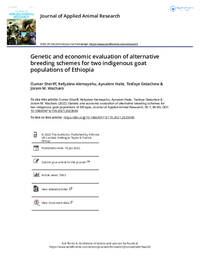Genetic and economic evaluation of alternative breeding schemes for two indigenous goat populations of Ethiopia

Authors:
In this study, breeding objective traits were identified, and alternative breeding schemes were simulatedand evaluated for two goat populations. The traits were as follows: body size, twinning ability and kiddinginterval (KI) for Arab goats and body size, twinning ability and mothering ability for Oromo goats. Theselection criteria were six-month weight (6mw, kg), litter size at birth (LSB), litter size at weaning (LSW)and KI (days). The schemes were as follows: (1) Scheme 1: 2 years of buck use and 10% selectionproportion, (2) Scheme 2: 2 years of buck use and 15% selection proportion, (3) Scheme 3: 3 years ofbuck use and 10% selection proportion, and (4) Scheme 4: 3 years of buck use and 15% selectionproportion. The predicted annual genetic gain (PAGG) for 6mw ranged from 0.29 to 0.32 kg for Arabgoats while it varied from 0.34 to 0.38 kg for Oromo goats. On the contrary, the PAGGs for LSB andLSW for both populations were considerably small regardless of the different schemes. The economicreturn (Euro/doe) ranged from 0.99 to 1.15 for Arab goats and from 0.60 to 0.70 for Oromo goats.SCM2 is recommended over other schemes.
